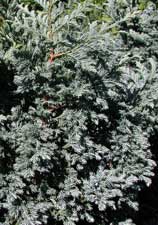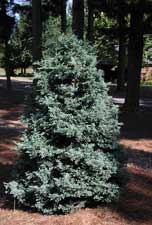Resource Library
Plant of the Week: Falsecypress, Boulevard
The University of Arkansas System Division of Agriculture does not promote, support or recommend plants featured in "Plant of the Week." Please consult your local Extension office for plants suitable for your region.
Plant of the Week
Boulevard Falsecypress
Latin: Chamaecyparis pisifera

Most gardeners have experienced plant lust and its sister, envy. For me I've always envied gardeners in the cool, moist maritime climate of the Pacific Northwest or England where everything seems to grow so effortlessly. One of the plants I have especially lusted after, Chamaecyparis pisifera ‘Boulevard' (Boulevard Falsecypress), will grow just fine in the South if you satisfy its minimal needs.
Boulevard falsecypress is one of the "Squarrosa" cultivars of falsecypress, a juvenile needle-leafed evergreen selected form of a Japanese forest tree. While the species will grow to 60 feet or more, Boulevard is usually under ten feet tall with a narrow, upright form. The foliage is silvery, blue gray and soft to the touch. So soft it cries out to be petted.
In the summertime Boulevard is a bit less blue but still stunning. Flowers and fruit are of not produced on the juvenile form. As plants age they develop "dead zones" in the interior of the plant and become a bit ratty looking towards the base. In New England this cultivar can grow to 20 feet tall. In Arkansas you can expect a 3-foot tall bush to reach 6- to 8- feet in a decade.
Boulevard is but one of many worthy Chamaecyparis cultivars offered by area nurserymen. This form was introduced by George Hall in 1862. He was a New England physician turned importer who shipped important landscape plants such as Aucuba, Japanese maple cultivars, Japanese yew, two spring blooming deciduous magnolias, several crabapples and ten garden selections of Chamaecyparis back to Parson's Nursery in Flushing, N.Y. during the Civil War. Hall was one of the first traders to arrive in Japan after Commodore Perry forced Japan, under threat of invasion, to open for American trading in 1854.
These dwarf and slow growing conifers have never been widely planted in the South, partly because they weren't generally available and partly because they look a lot like junipers which turned off many southern gardeners in the 50's and 60's because of overplanting and problems with bagworms.

But now that the Pacific Northwest has become the new center of nursery propagation for the nation, Chamaecyparis cultivars are being produced in large numbers and shipped to new markets throughout the nation. Though they are grown to perfection in cool, maritime climates, they are easy to grow in the South so long as their minimal needs are met.
Boulevard Falsecypress is ideally suited for used as small specimen plants in the rock garden or as an accent plant near a doorway or patio. It should be planted in full sun, or if possible, an area with bright morning sun and shade in late afternoon. Keep neighboring plants from crowing it too close. Because it is a slow but steady grower, it often outgrows the small space gardeners allot it.
Chamaecyparis do best in any reasonably well drained garden soil with a pH below 6.2. Boulevard is not wimpy about drought, but if there has been no rain in several weeks, it should be watered during the heat of summer.
By: Gerald Klingaman, retired
Extension Horticulturist - Ornamentals
Extension News - February 23, 2007
The University of Arkansas System Division of Agriculture does not maintain lists of retail outlets where these plants can be purchased. Please check your local nursery or other retail outlets to ask about the availability of these plants for your growing area.